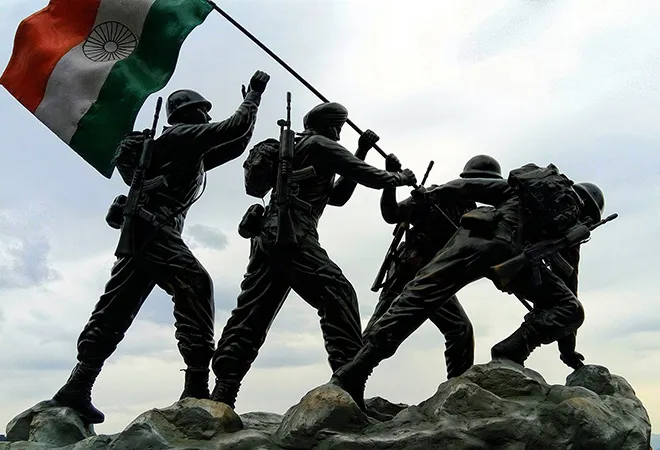-
CENTRES
Progammes & Centres
Location
Information operations have long been Pakistan’s preferred tool to execute and supplement its hybrid warfare in Jammu and Kashmir.

As India exercises its military options in the aftermath of the Pulwama terrorist attacks, international relations scholars have been blessed with new empirical evidence on deterrence theories and nuclear security. While many have analysed India’s conventional and nuclear military options, however, few have interrogated an equally consequential event: India’s first glimpse of wartime information operations.
Information operations have long been Pakistan’s preferred tool to execute and supplement its hybrid warfare in Jammu and Kashmir. In the second half of the 20th century, Pakistan leveraged cold war dynamics to successfully assert that India was a “colonial power” exercising illegitimate rule over Jammu and Kashmir. The fact that these narratives continue to exist even after 9/11 and rapidly changing attitudes towards terrorism speaks to their resilience.
Pakistan’s actions in the days following Pulwama have now given India a first taste of what such operations may look like in a period of war. At least four distinct narrative tools have become obvious.
The fact that these narratives continue to exist even after 9/11 and rapidly changing attitudes towards terrorism speaks to their resilience.
First, misinformation about the efficacy of India’s military operations. Soon after India’s air strikes in Balakot, a region deep within Pakistani territory, official and quasi-official Pakistani social media handles were attempting to pre-empt India’s official announcement by claiming that the attacks took place at Balakote, a region significantly closer to the Line of Control. They similarly claimed that India’s assertion about the number of terrorist casualties was a lie. Pakistan was also falsely claiming that the PAF shot down two Indian aircraft by mid-afternoon in on the 27 February, following skirmishes with the IAF.
Second, reversing narratives on casus belli and undermining Indian momentum. Imran Khan’s speech following the unfortunate capture of an Indian pilot was obvious in tone and tenor: it suggested that India was responsible for escalating tensions and that the onus was on Delhi to correct the situation. This is despite the fact that Pakistan targeted military positions in response to India’s pre-emptive strikes against terrorist organisations. Soon after, the hashtag #SayNoToWar was trending in both Pakistan and India, creating potential political barriers for further Indian escalation.
Third, questioning the legitimacy of India’s stated objectives and highlighting potential hypocrisy. Soon after India’s air strikes, Karnataka BJP State President Yedurappa claimed that the party would win elections in Karnataka as a consequence of these military actions. While this was undoubtedly bluster and bluff from a typical Indian politician, political parties in Pakistan have leveraged such statements to undermine the legitimacy of India’s military actions.
Finally, exacerbating existing political divisions. The decision to undertake military action is always political. In a democratic society like India, there is bound to be intense disagreement about the legitimacy and efficacy of military operations. The extreme polarisation in Indian public opinion after the capture of an Indian pilot is a testament to this. It would not be a stretch of imagination to assume that Pakistan may attempt to cleave Indian public opinion and ferment polarisation on social media.
In a democratic society like India, there is bound to be intense disagreement about the legitimacy and efficacy of military operations. The extreme polarisation in Indian public opinion after the capture of an Indian pilot is a testament to this.
In the midst of all this, it was apparent that India’s state apparatus was woefully ineffective. It took over seven hours for the Indian government to release an official statement of events following the airstrikes in Balakot. It took over five hours to confirm air skirmishes over Kashmir and the capture of an Indian pilot by Pakistan. Further, reporting from outlets such as Reuters, the Atlantic Council’s Digital Forensics Research Labs and Al-Jazeera, which suggest that there were limited or no terrorist casualties in Balakot, have only undermined India’s official claims.
Apart from presenting evidence that a Pakistani F-16 fighter jet fired missiles at Indian targets during the tri-services press briefing on the 28 February, India has largely been unable or unwilling to provide reliable and timely public evidence about the efficacy of its offensive and defensive operations. The Indian government also failed to respond effectively to the narrative that de-escalating the issue would require India to forgo future military options.
While the events over the past two days suggest that these “operations” were largely organic and independent of any centralised control, it is easy to see what lessons Pakistan can take away from them.
Taken together, well-coordinated information operations could potentially undermine India’s ability to set the political and strategic agenda bilaterally with Pakistan, multilaterally with other powers, and even domestically, with its own public. While the events over the past two days suggest that these “operations” were largely organic and independent of any centralised control, it is easy to see what lessons Pakistan can take away from them.
Pakistan is at a deep disadvantage in terms of conventional military power. This is why it leverages asymmetric options like terrorism. As information communication technologies increasingly replace the traditional public sphere, Pakistan is presented with new options to effectively undertake influence operations. These tactics are also easily supplemented by new technologies like artificial intelligence. Machine learning technique called “generative adversarial network,” for example, can create realistic fake videos, or “deep fakes,” which appear authentic. Such techniques could easily be used to sow confusion during wartime. That India is still a developing country, home to many social cleavages, only heightens such a risk.
As an open society, India cannot control massive information flows. India is also compelled to respond to a 24/7 news cycle, with the public demanding official information rapidly.
If the Indian government was truly caught off-guard, it is imperative to learn lessons from the events of the past few days. As an open society, India cannot control massive information flows. India is also compelled to respond to a 24/7 news cycle, with the public demanding official information rapidly. Failing to effectively respond to misinformation and propaganda could lead to uncertain feedback loops between Indian public sentiment, political calculations and military objectives. Whenever India conducts an official post-mortem of its retaliatory strikes, it would do well to dissect how information operations could undermine its strategic objectives in the future.
Beyond short term measures, it is also time for India to recognise this new calculus in its assumptions about war — that military operations will also be about capturing mind space. If the “fog of war” once connoted limited actionable information available to military actors, today it could easily mean an overload of (mis)information during war. India must prepare its society, government and military to respond to, and even carry out, information operations in the future.
The views expressed above belong to the author(s). ORF research and analyses now available on Telegram! Click here to access our curated content — blogs, longforms and interviews.

Akhil Deo was Junior Fellow at ORF. His interests include urban governance sustainable development civil liberties cyber governance and the impact of future technologies on ...
Read More +